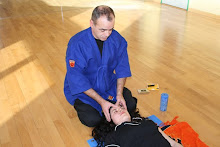POSTURA – ACTITUD – ALINEACION CORPORAL – RESPIRACION Y TECNICA EN EL KARATE TRADICIONAL
1. El énfasis que debe todo instructor de Karate realizar antes de cada clase es la posición del cuerpo. Nishiyama Sensei lo indicaba en cada una de sus clases o seminarios.
2. Dos elementos principales cuentan en este proceso, uno el mental y el otro físico. Es allí que debemos de incluir la Actitud en la parte mental y la Alineación Corporal en la física.
POSTURA:
· Deseo hacer énfasis en que la condición física y la practica cotidiana del Karate Tradicional van a colaborar en ella; pero sin las indicaciones permanentes del Instructor o la conciencia del practicante es muy posible que nuestro cuerpo intente dominar ciertos hábitos adquiridos por la vida cotidiana: ordenador, coche, marcha etc…
· Encontramos mucha información para corregir la postura y dentro de los Artes marciales el Karate es una respuesta. Es allí donde aparece la:
ACTITUD:
· Es en ella donde veremos el avance del alumno considerablemente, dicha experiencia la realicé en una semana de trabajo con un grupo de Karate Tradicional de Costa Rica (2009), donde los alumnos y principalmente niños, luego de culminada cada clase, le notábamos una actitud y postura completamente distinta y mejorada. Al final del seminario las acciones de cada uno de ellos con respecto a la concepción del cuerpo en el espacio colaboró con la:
ALINEACION CORPORAL
· A partir de todas las indicaciones y la repetición de las acciones antes de la práctica y durante ella el cuerpo comienza a alinearse y a comprender el equilibrio tanto en las posturas de pie como en los desplazamientos y giros, manteniendo el eje del cuerpo perpendicular al suelo y sintiendo la presión al mismo para realizar cada movimiento, eso colabora con la:
RESPIRACION:
· El bajo vientre (3 a 4 centímetros por debajo del ombligo) Tandem (en japonés) y un punto entre las 2 cejas Kami Tandem, están relacionados con la respiración. Es cierto que el acto físico de respirar es algo natural, pero en el Karate Tradicional estos 2 puntos mencionados tienen un elemento común que si los disociamos la técnica y el impacto serían completamente diferentes. Es desde allí donde llegamos a la:
TECNICA:
· Para poder cumplir con la exigencia y evolución técnica debemos cumplir antes los 4 puntos mencionados anteriormente. Estudiemos la técnica a través la aplicación de ellos y la practica del Kata como elemento de unión de todos ellos.
Es así que invito a todos vosotros a investigar en este tema para ofrecerle a los practicantes elementos de estudio que colaboren en el crecimiento de su performance total. Creo que con ello todos saldremos favorecidos.
Muchas gracias
Nelson Carrión



